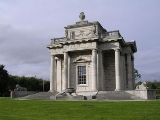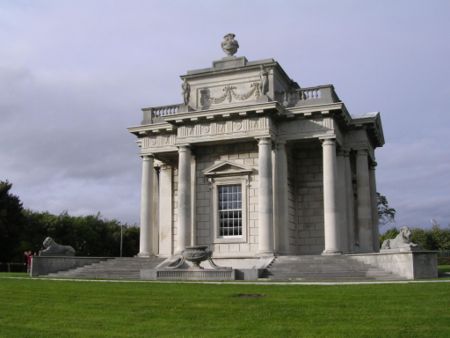
Casino at Marino
Encyclopedia

Marino, Dublin
Marino is a Northside suburb located in Dublin, Ireland.-Location and access:Marino encompasses the area within the boundaries of Sion Hill Road, Gracepark Road, Philipsburgh Avenue , Malahide Road and Shelmartin Terrace. Marino borders other Northside areas such as Fairview, Donnycarney and...
, Dublin, Ireland
Republic of Ireland
Ireland , described as the Republic of Ireland , is a sovereign state in Europe occupying approximately five-sixths of the island of the same name. Its capital is Dublin. Ireland, which had a population of 4.58 million in 2011, is a constitutional republic governed as a parliamentary democracy,...
was designed by Scottish
Scotland
Scotland is a country that is part of the United Kingdom. Occupying the northern third of the island of Great Britain, it shares a border with England to the south and is bounded by the North Sea to the east, the Atlantic Ocean to the north and west, and the North Channel and Irish Sea to the...
architect Sir William Chambers
William Chambers (architect)
Sir William Chambers was a Scottish architect, born in Gothenburg, Sweden, where his father was a merchant. Between 1740 and 1749 he was employed by the Swedish East India Company making several voyages to China where he studied Chinese architecture and decoration.Returning to Europe, he studied...
for James Caulfeild
James Caulfeild, 1st Earl of Charlemont
James Caulfeild, 1st Earl of Charlemont KP PC was an Irish statesman.The son of the 3rd Viscount Charlemont, he was born in Dublin, and succeeded his father as 4th Viscount in 1734...
, the 1st Earl of Charlemont, starting in the late 1750s and finishing around 1775. It is a small and perfect example of Neo-Classical architecture, situated in the gardens of Marino House. Although proud of the design, it is notable that due to his constant employment in England, Chambers was never able to visit the completed building.
Name
The name 'Casino' is the diminutive form of the 18C Italian word 'Casa', meaning 'House', thus 'Little House', and is not used in the modern sense of "gambling establishment". Caulfield was taken with all things Italian and decided to add a 'little house' to his estate, which he had already named after the town of Marino in Lazio.Design
Widely regarded as the most important Neo-Classical building in Ireland, the Casino is actually quite small, measuring only fifty feet square to the outer columns. In plan, it takes the form of a Greek Cross with a pair of columns framing each projecting elevation. Seen from the outside, the building has the appearance of a single roomed structure, with a large panelled door on the north elevation and a single large window on each of the other elevations. This is all illusion, however, as it actually contains 16 rooms on three floors. Only two of the panels in the door open to allow entrance, and the panes of glass in the windows are subtly curved, disguising the partitioning which allows what looks like a single window to serve several separate rooms.Many other tricks are used throughout the construction in order to preserve the apparent simplicity of the design. Four of the columns which surround the building are hollow and,with a length of chain dangling in each, allows rainwater to drain down. The Roman funerary urns on the roof (designed by Vierpyl) are used as chimneys.
The interior, again by Virple, includes a basement level with a kitchen and associated rooms, a main floor with reception rooms and a top storey with servants rooms and a State Bedroom. It contains some very fine plasterwork ceilings and some elaborate hardwood parquet floors.
Originally the Casino was linked to Marino House by a tunnel, although this has been blocked off due to building works in the area.

